About this finishing
Print. The image is printed on the top quality 10-ink HP Z9PS printer on HP matte 270 g / m2 paper. You can choose any size to an accuracy of 1 cm. A margin of 5 cm around the image is added to the size of the motif.


You can find a detailed description about our finishings
here.
A flock of birds
Date:
1917Medium:
pencil, ink, woodLocation:
private collection"Flock of Birds" (German "Vogelschar") is an oil painting by the Swiss painter
Paul Klee , created in 1922. This work is a characteristic example of Klee's style, which combines
abstract and surrealist elements. The painting shows a flock of birds, but these birds are completely abstract and unmistakable. Klee used geometric shapes and lines to create birds that resemble letters, symbols, and other abstract elements. The birds are arranged in such a way that they create dynamic movement and at the same time give the impression of something dreamy.
Klee's composition is organic to a certain extent, although it includes abstract elements. The birds are positioned to give the impression of movement and life. Paul Klee's works often contain mystical and
symbolic elements. "Flock of Birds" can be interpreted in different ways, and each viewer can find their own meaning in the abstract shapes. Klee was an active artist during the modernist era and his works were influenced by various artistic movements, including abstraction and surrealism.
Klee painted picture A flock of birds in 1917. Prevailing color of this fine art print is vivid and its shape is portrait. This art piece is located in a private collection This image is printed on demand - you can choose material, size and finishing.
Paul Klee (1879-1940). From childhood, he was interested in both music and painting, but as is evident, finally decided on painting - his paintings are among prized artworks. In Munich, he met
Kandinsky, Franz Marc, and other artists of the then avant-garde. He met also his future wife, pianist Lily Stumpf. His work is associated with a
expressionism, cubism, and
surrealism. He was one of the four Die Blaue Vier (with Kandinsky, Feininger and Jawlensky). He taught at Bauhaus and the Düsseldorf Academy until 1933, when the Nazis declared his paintings a figment of a sick soul and with labelled his whole creation as degenerate art. Klee was extremely hardworking and after his death, he left behind 8926 works in Switzerland. Klee’s paintings are fragile, with a sensitive use of color (his colour mixing ranks among the world’s best) and frequent references to poetry, music and dreams.


